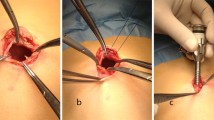Abstract
Background
Inguinal hernia in children is traditionally repaired through a groin incision by dissecting the hernia sac from the spermatic cord and suture ligating its base. A laparoscopic modification of this procedure involves placement of a transcutaneous suture around the neck of the sac through a 2-mm stab incision under visualization with an umbilically placed 2.7-mm 30o lens. We reviewed the clinical outcome of this novel procedure at our institution.
Methods
Prospective review of 275 hernias in 187 children (144 male, 43 female) performed laparoscopically by a single surgeon between September, 2002 and June, 2005. Data analyzed included side of hernia, incarceration, prematurity, recurrence rate, and complications.
Results
30 left, 69 right, and 25 bilateral hernias were repaired. Sixty-three unilateral hernias had a contralateral patent processus vaginalis that was repaired. Mean operative time for a bilateral repair was 17 min. Two procedures were for recurrence after open repair. Forty-nine patients were ex-premature infants, accounting for 79 repairs. Fifteen cases followed reduction of incarcerated hernias, nine of whom were in preterm infants. Four out of 275 hernias (1.5%) recurred in four patients (mean age 4.5 years; 3 male, 1 female). There were four superficial wound infections, two umbilical granulomas, two hydroceles, and six self-resolving hematomas. There were no spermatic cord injuries, testicular atrophy, or symptoms of ilioinguinal nerve injuries.
Conclusion
This novel laparoscopic inguinal hernia repair is an effective method in children, with recurrence rates comparable to the traditional approach. Advantages of the laparoscopic operation include a “no-touch” approach to the spermatic cord structures, a virtually virgin operative field in cases of recurrence, and excellent cosmesis. Disadvantages include peritoneal access and nonhermetic seal in males.





Similar content being viewed by others
References
Glick PL, Boulanger SC (2006) Inguinal Hernias and Hydroceles. In: Grosfeld JL, O’Neill JA, Coran AG, Fonkalsrud EW (eds) Pediatric surgery, vol 2, 6th edn. Philadelphia, Mosby, pp 1172–1192
Schier F, Montupet P, Esposito C (2002) Laparoscopic inguinal herniorrhaphy in children: a three-center experience with 933 repairs. J Pediatr Surg 37:395–397
Gorsler CM, Schier F (2003) Laparoscopic herniorrhaphy in children. Surg Endosc 17:571–573
Chan KL, Tam PK (2004) Technical refinements in laparoscopic repair of childhood inguinal hernias. Surg Endosc 18:957–960
Chan KL, Hui WC, Tam PK (2005) Prospective randomized single-center, single-blind comparison of laparoscopic vs open repair of pediatric inguinal hernia. Surg Endosc 19:927–932
Harrison MR, Lee H, Albanese CT, Farmer DL (2005) Subcutaneous endoscopically assisted ligation (SEAL) of the internal ring for repair of inguinal hernias in children: a novel technique. J Pediatr Surg 40:1177–1180
Ozgediz D, Roayaie K, Lee H, Nobuhara KK, Farmer DL, Bratton B, Harrison MR (2007) Subcutaneous endoscopically assisted ligation (SEAL) of the internal ring for repair of inguinal hernias in children: report of a new technique and early results. Surg Endosc 21:1327–1331
Author information
Authors and Affiliations
Corresponding author
Rights and permissions
About this article
Cite this article
Dutta, S., Albanese, C. Transcutaneous laparoscopic hernia repair in children: a prospective review of 275 hernia repairs with minimum 2-year follow-up. Surg Endosc 23, 103–107 (2009). https://doi.org/10.1007/s00464-008-9980-2
Received:
Revised:
Accepted:
Published:
Issue Date:
DOI: https://doi.org/10.1007/s00464-008-9980-2




